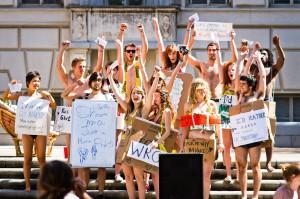SurveillanceFusion centers collect information on non-threatening groups
Since the 9/11 attacks, federal and state surveillance of nonviolent student groups, protest movements, and mosques has increased along with the growth of fusion centers. Fusion centers serve as the focal points for the receipt, analysis, gathering, and sharing of threat-related information. According to DHS, there are fifty-three primary fusion centers and twenty-five recognized fusion centers across the United States.

USAS demonstrators considered potential threat by fusion centers // Source: usas.org
Since the 9/11 attacks, federal and state surveillance of nonviolent student groups, protest movements, and mosques has increased along with the growth of fusion centers. Fusion centers serve as the focal points for the receipt, analysis, gathering, and sharing of threat-related information. According to DHS, there are fifty-three primary fusion centers and twenty-five recognized fusion centers across the United States. Primary fusion centers are designated by the federal government, while recognized fusion centers are designated by state governments.
MPN reports that reports claim that law enforcement officers have been extending legal boundaries in pursuit of criminals or potential terrorists. The intentions of these agencies may be positive, but reports point out that some agencies have been targeting organizations which do not prove to be a threat. One case in point is that of United Students against Sweatshops (USAS). The Washington Post reported earlier this month that a Washington, D.C police officer known as “Rizzy” posed as an activist and member of the group. Rizzy was claimed to have illegally infiltrated and monitored the group by attending meetings and protest. USAS filed a lawsuit claiming the officer did not have permission to be deployed in an undercover capacity. “The allegation is not that the undercover officer took photos and videos of USAS, but that she should not have been deployed in an undercover capacity in the first place,” said Jeffrey Light, an attorney representing USAS, in a written statement to Mint Press News.
The Cato Institute published a 2011 report, titled We’re All Terrorists Now, which cites several incidents in which fusion centers have overreached and violated civil liberties.
“The North Texas Fusion System labeled Muslim lobbyists as a potential threat; a DHS analyst in Wisconsin thought both pro- and anti-abortion activists were worrisome; a Pennsylvania homeland security contractor watched environmental activists, Tea Party groups and a Second Amendment rally; the Maryland State Police put anti-death penalty and anti-war activists in a federal terrorism database; a fusion center in Missouri thought that all third-party voters and Ron Paul supporters were a threat; and the Department of Homeland Security described half of the American political spectrum as ‘right-wing extremists,’” the report states.
Some lawmakers have also begun to question fusion centers’ authority and effectiveness. According to Senator Tom Coburn (R-Oklahoma), Homeland Security and Public Affairs Subcommittee ranking member, “It’s troubling that the very ‘fusion’ centers that were designed to share information in a post-9/11 world have become part of the problem. Instead of strengthening our counterterrorism efforts, they have too often wasted money and stepped on Americans’ civil liberties.”
It should be noted that members of Congress from both parties – for example, Senator Diane Feinstein (D-California) and Representative Peter King (R-New York) – flatly dismissed Coburn’s assertions about the effectiveness of the fusion centers.
